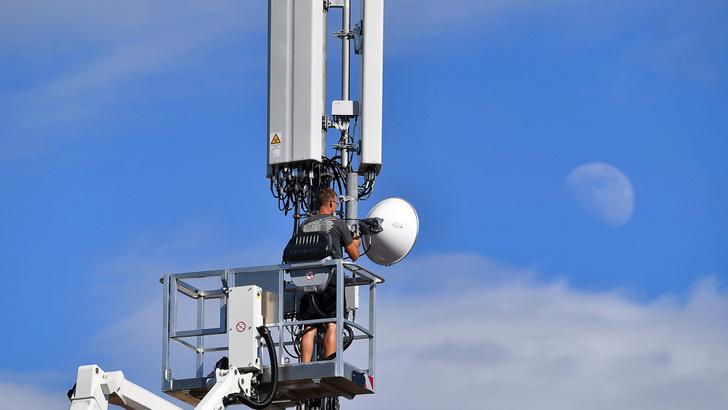5G is booming – at least according to the latest figures from the Global mobile Suppliers Association (GSA).
In a webinar titled "GSA Snapshot: 5G year in review," the association noted that while 2020 saw 5G move to center stage, 2021 has seen continued growth for 5G infrastructure deployment and service launches.
Simon Sherrington, VP of research at the GSA, said that by December 2021 481 operators in 144 countries or territories were investing in 5G.

Build it: The GSA forecasts that more than 200 5G networks will have been deployed by the end of Q1 2022. (Source: dpa picture alliance / Alamy Stock Photo)
"When we talk about investing in 5G, we mean investing in trials and tests, investing in licenses to enable the deployment of 5G services, investing in the deployments themselves or pilot projects, or those that have actually launched services as well," Sherrington explained.
Of the 481 operators, 189 operators in 74 countries or territories have now launched one or more 3GPP-compliant 5G services, with five so-called "soft" launches also recorded.
Out of the 189, 177 have launched 3GPP-compliant 5G mobile services, with some also offering fixed wireless access (FWA) services. Around 12 operators are providing only FWA services.
"If we compare those numbers to where we were at the start of the year: at the end of 2020, 135 operators had launched a 3GPP-compliant 5G service," said Sherrington. That means there has been a 40% increase over the course of 12 months.
"And by way of comparison, while there is no exact overlap between the LTE and 5G datasets, it does mean that the equivalent of nearly a quarter of all LTE operators have now launched 5G services, which is significant," he added.
Further launches are also pending, with the GSA forecasting that more than 200 5G networks will have been deployed by the end of the first quarter of 2022 – or soon thereafter.
"Then of course there's the next generation of 5G – 5G standalone," said Sherrington.
"The GSA is now tracking 98 operators investing in 5G standalone public networks, and 47 of those are known to be actively deploying 5G standalone technologies."
GSA has catalogued 54 mobile processors/platforms or discrete modems announced as supporting 5G standalone (SA) networks.
It is also tracking 663 announced devices with claimed support for 5G SA, up from just over 280 in December 2020, of which 49% are phones, 20% are FWA CPE, and 20% are modules. Of those, 461 devices are already commercially available, up 162% from 176 in December 2020.
FWA and private networks: Two growing trends
The GSA noted that FWA is now a key element of the 5G service package. It has catalogued 81 operators that are marketing residential or business 5G FWA broadband services, up more than 84% from 44 in 12 months.
Around 32% of service providers promote speed-only based tariff structures and 36% promote volume-only based tariff structures. Quoted peak download speeds range from 50 Mbit/s to 4.2 Gbit/s, with just over half of services sitting in the 250 Mbit/s to 1000 Mbit/s range.
Further interesting trends include the rising popularity of private mobile networks based on both LTE and 5G, with the manufacturing sector regarded as particularly innovative in this area.
"The exact number of existing private mobile network deployments is hard to determine because details are often not made public," said Sherrington.
"There are 664 organizations that have deployed or are deploying private mobile networks based on LTE or 5G," he said. "A quarter of them involve the deployment of 5G technology."
"It really demonstrates the attraction of 5G technology for enabling the transformation in supply chains and manufacturing environments, and the benefits are clearly evident to corporate public sector and government users," Sherrington added.
Nothing would be possible without spectrum, of course. Governments have been holding more auctions, and operators have been quick to deploy services.
Want to know more about 5G? Check out our dedicated 5G content channel here on Light Reading.
In the C-band (3.3GHz to 4.2GHz; the n77, n78, n79 bands), 218 operators have been licensed, have deployed or are deploying 5G networks. In the millimeter wave (mmWave) bands at 26/28 GHz, 93 licenses have been awarded and 27 networks have been or are being deployed.
In addition, 700MHz is becoming increasingly important for 5G with 24 auctions and assignments expected by the end of 2023.
Last but not least, devices are pretty crucial to allow these networks to be used.
The GSA noted that 5G chipset availability has improved rapidly in the last two years, and has identified 47 commercially available 5G mobile processors or platforms (up 88% in a year) and 17 commercially available discrete 5G modems (up 70%).
The number of announced 5G devices now exceeds 1,200, and more than 1,000 devices are expected to be launched commercially by the end of Q1 2022.
The supplier system is also pretty vibrant: more than 170 vendors have announced available or forthcoming 5G devices, and over 120 vendors have launched commercially available devices.
